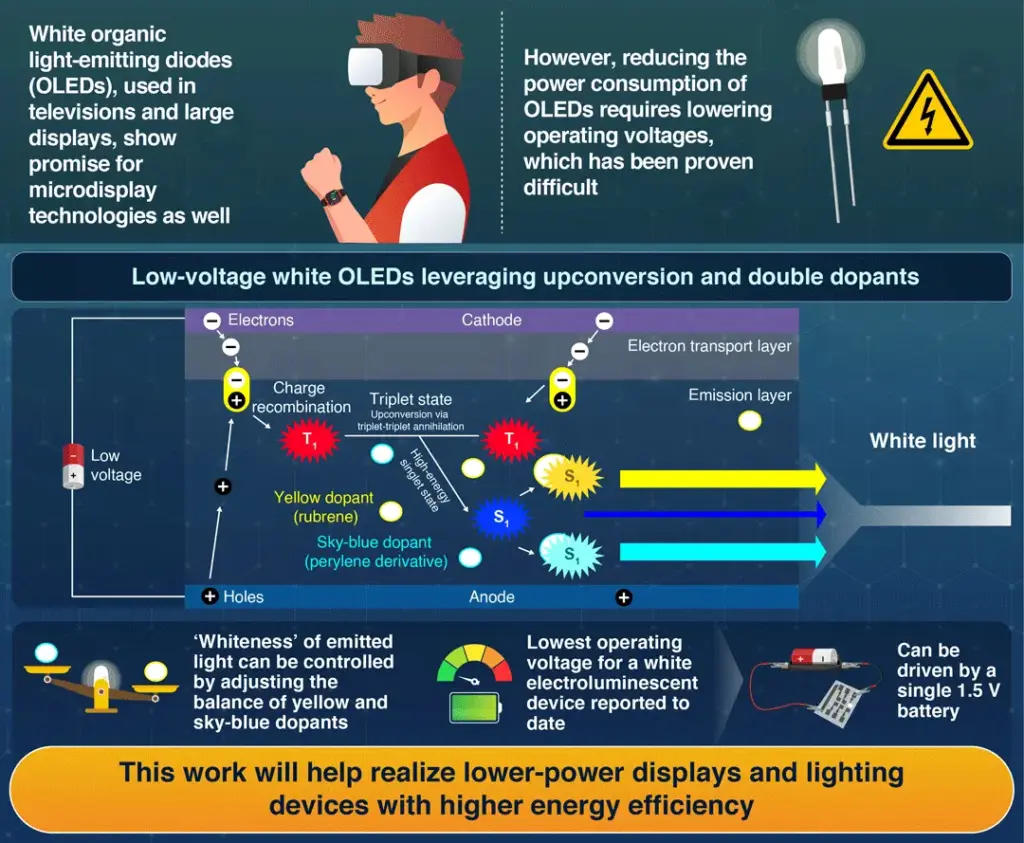
A groundbreaking development in organic light-emitting diode (OLED) technology has been reported by researchers from the Institute of Science Tokyo, Japan. The team has successfully engineered a white OLED that operates at under 1.5 volts, a significant reduction from the typical 2.5 volts required. This advancement, achieved through the use of triplet-triplet annihilation to generate blue light and the integration of yellow and sky-blue dopants, promises to substantially decrease energy consumption in modern display technologies.
The announcement comes as OLEDs continue to transform display industries, offering vibrant colors and sleek designs for devices ranging from televisions to virtual reality headsets. Despite their advantages, the high power consumption of white OLEDs has limited their use in portable electronics, a challenge that this new development seeks to overcome.
Towards Energy-Efficient Microdisplay Technologies
OLEDs have long been celebrated for their superior visual quality, but their relatively high power demand has been a barrier to broader application, especially in battery-operated devices. The high voltage necessary to produce white light has been a significant hurdle, with most current technologies requiring over 2.5 volts. This is largely due to the energy needed to generate blue light, a key component of white light.
According to sources, extensive research has focused on enhancing the efficiency and color accuracy of white OLEDs. However, reducing their operating voltage has remained a persistent challenge until now. The recent study led by Associate Professor Seiichiro Izawa marks a pivotal moment in overcoming this obstacle.
The Science Behind the Breakthrough
Published in the Journal of Materials Chemistry C, the research details the innovative approach taken by Izawa’s team. Building on previous work with low-voltage blue OLEDs, the team employed a process known as triplet-triplet annihilation (TTA). This method involves driving negative and positive charges within a layered organic semiconductor device at low voltage. When these charges recombine, they create excited electronic states called triplet states, which can interact to form a higher-energy singlet state that emits blue light.
To achieve white light, the researchers incorporated two dopants into the emissive layer: a sky-blue dopant (Tbpe) and a yellow dopant (rubrene). These dopants, activated by the singlet states, emit their respective colors, which combine to produce white light. The precise adjustment of the dopant ratios was crucial to achieving the desired ‘whiteness’ of the output.
“To the best of our knowledge, this is the lowest operating voltage reported to date for white OLEDs,” highlights Izawa, emphasizing the significance of their achievement.
Implications for Future Technologies
The move represents a significant leap forward in the development of energy-efficient displays. By lowering the operating voltage of white OLEDs, the study paves the way for new designs in portable electronics, such as wearable devices used in entertainment, sports, and health monitoring. Izawa notes, “Our achievement could contribute to the realization of a more energy-efficient society by enabling lower-power-consuming displays and lighting devices.”
Meanwhile, the research team is focused on refining the technology further, addressing challenges related to efficiency and color stability. This ongoing work brings us closer to a future where high-quality displays can operate with minimal energy consumption, aligning with global efforts towards sustainable technology solutions.
This development follows a series of innovations in OLED technology, underscoring the potential for these devices to revolutionize how we interact with electronic displays. As researchers continue to push the boundaries of what’s possible, the implications for consumer electronics and environmental sustainability are profound.







